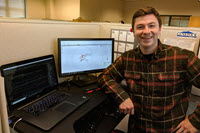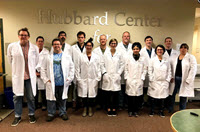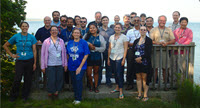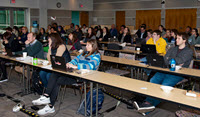
Meiofauna are microscopic marine organisms that live between grains of sand in ocean, coastal, river, and stream sediments and provide important services such as recycling organic material in the sediment that contribute to healthy marine ecosystems. Additionally, meiofauna are intermediary consumers between microbes and prey of larger organisms in marine food webs, and as such, can be early indicators of environmental disturbances, such as oil spill pollution, that could affect broader ecosystem health.
Joseph Sevigny uses genetic research techniques to expand our knowledge about meiofauna taxonomy and improve the way we analyze and monitor these communities. His work to develop novel methods for efficient genomic analysis can reduce the time it takes researchers and responders to survey and monitor how meiofaunal communities recover from environmental disturbances.
Joseph is a Ph.D. student with the University of New Hampshire’s Hubbard Center for Genome Studies and a GoMRI Scholar with the project Genomic Responses to the Deepwater Horizon Event and Development of High-Throughput Biological Assays for Oil Spills.
His Path

Joe has been fascinated with understanding how the natural world works since he was a child. Reading scientific authors such as Matt Ridley and Richard Dawkins sparked his interest in the engaging world of genetics, genomics, and computational biology. He began his undergraduate career as a Biology and Environmental Science dual major at New England College and conducted bioinformatics and genetics research full-time during the summer of his junior year. He collaborated with several institutions, including the University of New Hampshire’s Hubbard Center for Genome Studies, where he learned about Dr. Kelley Thomas’s GoMRI-funded research characterizing the taxonomy of benthic organisms such as meiofauna.
Joe’s work during that summer solidified his passion for comparative genomics research, and he later joined Dr. Thomas’s lab as a Ph.D. student. “Meiofauna don’t have the means to move to a different location after an environmental disturbance – they are stuck dealing with whatever comes into their homes,” he explained. “I want to help improve the way we analyze and monitor these communities through DNA sequencing and highlight their importance for investigating the impacts of oil spills.”
His Work

The first and most challenging step of Joe’s research was collecting and preparing the meiofauna for genomic analysis. Because most meiofauna species have not undergone genetic sequencing, he had to start from scratch. Joe and his colleagues developed techniques to sequence trace amounts of DNA from meiofauna but still needed to taxonomically identify them before they could proceed.
Since they are investigating a broad group of meiofauna (26 of the 35 known animal phyla), they needed help from taxonomic experts, so the team coordinated workshops such as the Benthic Invertebrate Taxonomy, Metagenomics, and Bioinformatics (BITMaB) with invited meiofaunal taxonomists from around the world. During the workshop, attendees collected and identified Gulf of Mexico meiofauna, which allowed them to sequence an extremely broad range of meiofaunal groups.
“This monumental task would have been impossible without collaborating with traditional taxonomists, who collect and identify individual animals using light microscopy and other techniques,” said Joe. “Through the workshops, the taxonomists got to learn how we analyze the data during bioinformatics sessions, and we were able to learn a lot about the process of collecting and identifying a diverse array of meiofaunal species. It was a win-win for us all!”

Joe extracted and prepared DNA from the identified specimens for genetic sequencing, which provided him with short DNA fragments. He then used bioinformatics principles to develop his own computer code for existing software to analyze the genetic data. His program assembled the short DNA fragments into complete genomes, expanding them to the size of a chromosome. He then analyzed the genes in the large sequences to determine what functions the meiofauna have, the biochemical processes they are capable of, and their evolutionary relationships.
Joe’s research will help reduce the time and effort involved in monitoring meiofaunal communities. Rather than going through the expensive, time-consuming taxonomic identification process, future researchers can sequence DNA directly from an environmental sample, link the resulting sequences to the database, and infer which meiofauna are present. “This process will allow for faster, broader, and more-accurate scale analyses of meiofaunal communities and populations than ever before, allowing us to determine which areas of the Gulf are most severely impacted and focus our recovery efforts on those places,” explained Joe. “Over time, we can utilize the same data to monitor how these communities are recovering and construct baseline data across the Gulf and around the world.”
His Learning
Joe worked on different projects during his time with Dr. Thomas, including research focusing on animal phylogeny and evolution, speciation, and developmental expression experiments. These diverse projects helped balance his background in computational genomics. The genomic workshops gave Joe an opportunity to share his computational methods knowledge while learning from experts in different fields and were a highlight of his graduate studies.

“I find it extremely rewarding that I can incorporate my skillset in molecular biology towards increasing our understanding and awareness of anthropogenic impacts,” he said. “Teaching a topic I really enjoy and sharing my knowledge with the next generation of scientists is extremely rewarding and motivating. These experiences have really shown me how much science benefits from an environment in which scientists from an extremely broad set of backgrounds come together for a common goal.”
His Future
Joe plans to continue his genomics research as a post-doc and eventually serve in a faculty position.
Praise for Joe
Dr. Thomas explained that Joe has a “uniquely engaging quality” that makes it easy for him to work alongside diverse collaborators from other fields. He particularly recalled Joe’s appreciation for the taxonomists and ecologists who participated in the workshops and their reciprocal appreciation for Joe’s ability to teach them the bioinformatics needed to utilize his team’s genomic data. “I believe his success stems from the fact that Joe is genuinely interested in their work,” he said.
Dr. Thomas also praised Joe’s teaching ability. Joe teaches a week-long summer course for college instructors called Train the Trainers (T3), which is based off of the bioinformatics workshop he helped develop for the GoMRI project. “Joe loves what he does, and it shows. He always receives rave reviews and requests to teach,” said Dr. Thomas. “He has contributed mightily to our GOMRI project and has a great career ahead of him using the skills that he developed during this project.”
The GoMRI community embraces bright and dedicated students like Joe Sevigny and their important contributions. The GoMRI Scholars Program recognizes graduate students whose work focuses on GoMRI-funded projects and builds community for the next generation of ocean science professionals.
By Stephanie Ellis and Nilde Maggie Dannreuther. Contact sellis@ngi.msstate.edu for questions or comments.
************
The Gulf of Mexico Research Initiative (GoMRI) is a 10-year independent research program established to study the effect, and the potential associated impact, of hydrocarbon releases on the environment and public health, as well as to develop improved spill mitigation, oil detection, characterization and remediation technologies. An independent and academic 20-member Research Board makes the funding and research direction decisions to ensure the intellectual quality, effectiveness and academic independence of the GoMRI research. All research data, findings and publications will be made publicly available. The program was established through a $500 million financial commitment from BP. For more information, visit https://gulfresearchinitiative.org/.
© Copyright 2010-2019 Gulf of Mexico Research Initiative (GoMRI) – All Rights Reserved. Redistribution is encouraged with acknowledgement to the Gulf of Mexico Research Initiative (GoMRI). Please credit images and/or videos as done in each article. Questions? Contact web-content editor Nilde “Maggie” Dannreuther, Northern Gulf Institute, Mississippi State University (maggied@ngi.msstate.edu).
